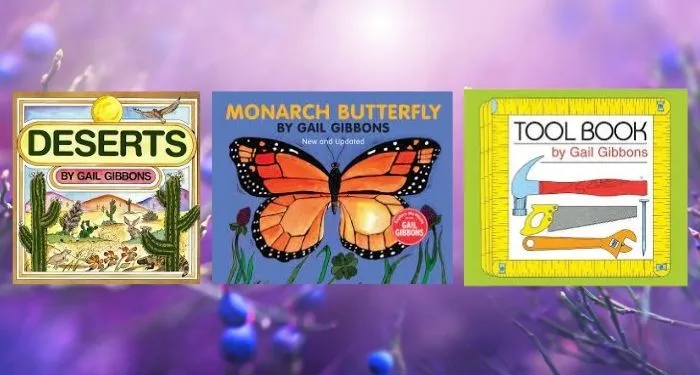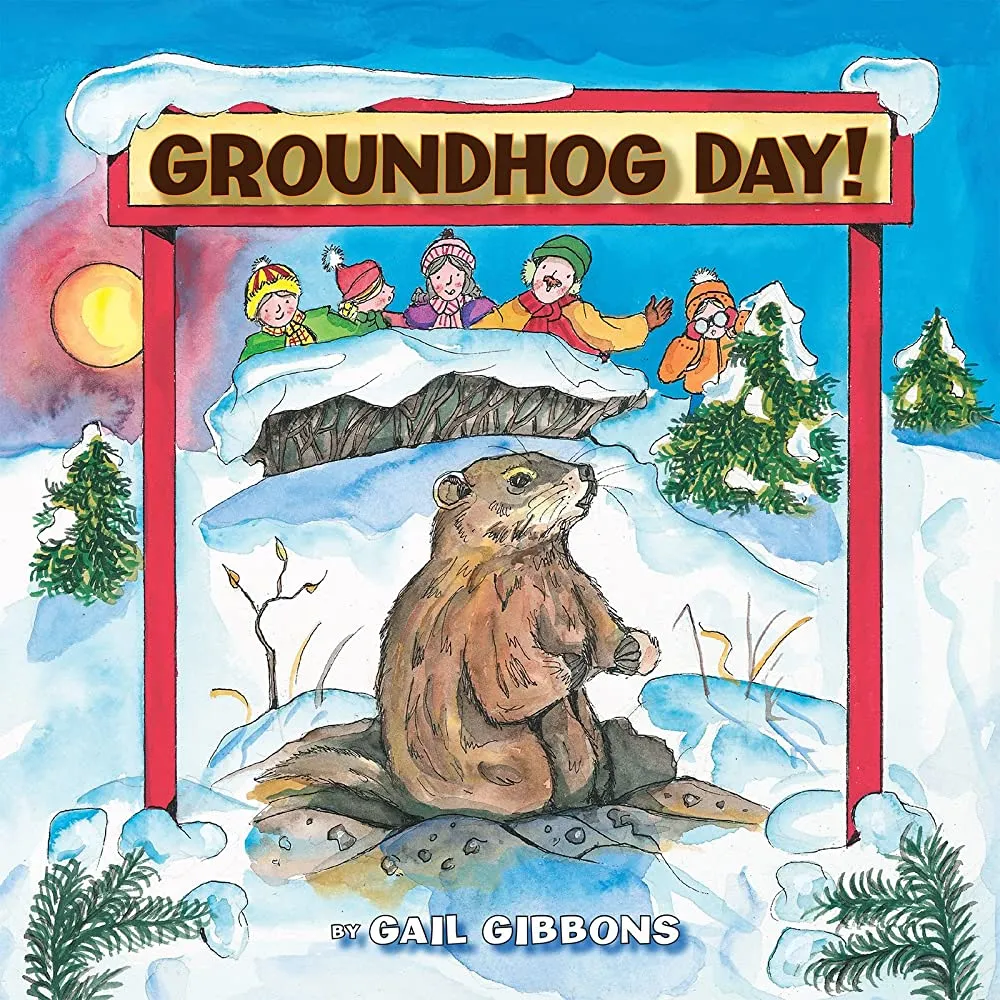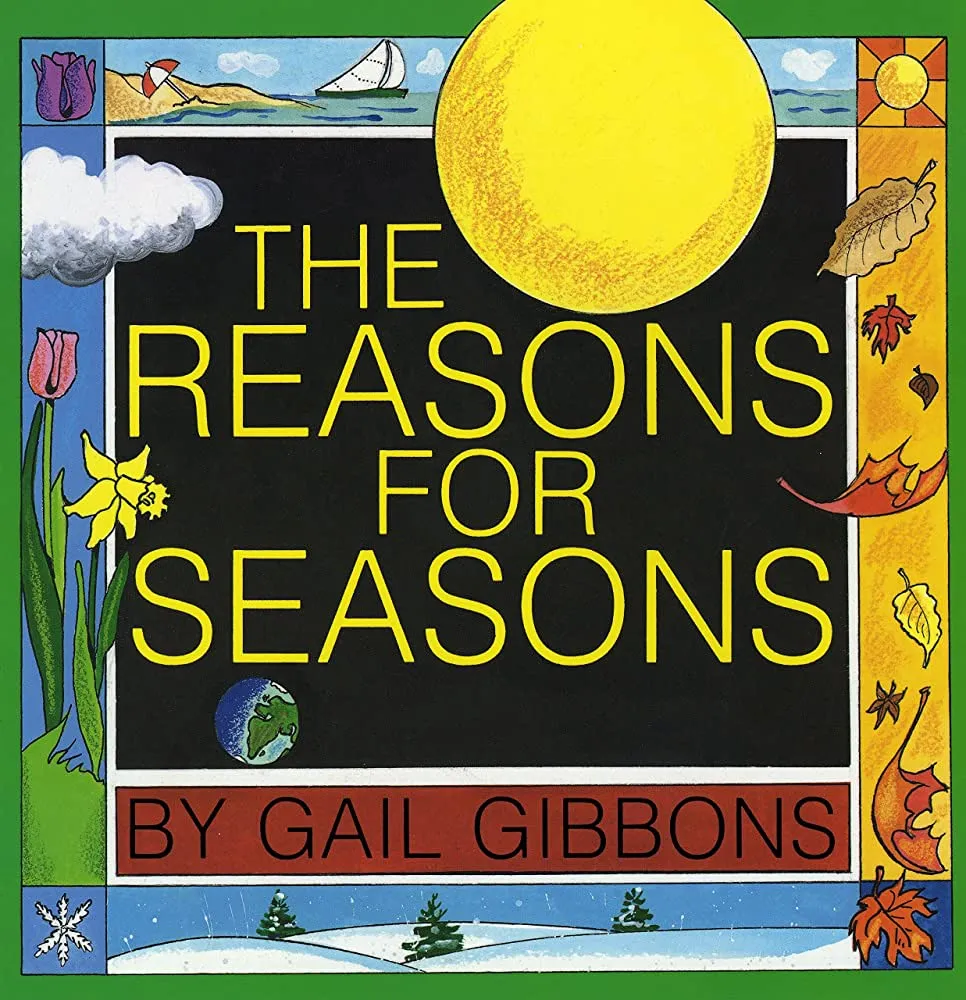
A Deep Dive into the Work of Gail Gibbons
If you have young kids, there’s a really good chance you’ve come across books by Gail Gibbons. Her children’s nonfiction is often on seasonal or holiday displays at the library, and if your child has an interest in something specific, especially about the natural world, she’s probably written a book about it. As a homeschooling parent of an early elementary-age kid, her books are in heavy rotation over here, and I’m constantly scouring the internet to see if there’s a book of hers that we need but don’t yet have for an upcoming or current area of study. Topics that Gibbons has written about include, but are not limited to: galaxies, hurricanes, tornadoes, sharks, deserts, Groundhog Day, gorillas, farming, the moon, bats, coral reefs, bicycles, fruits, vegetables, dinosaurs, snow, rain, pumpkins, monarch butterflies, how a house is built, elephants of Africa, and skyscrapers.
Each of her books has a main storyline, but then there are plenty of scientific or related terms that are listed and defined on each page, along with colorful and clear illustrations. At the end of the book, there are usually facts, an infographic, or a fun activity. Last year, she released a workbook that corresponded with her monarch butterfly book, along with one that went with From Seed to Plant, and in a perfect homeschool world, there’d be a workbook for each of her books. They were filled with such fun activities that my son had a blast and loved working on them.
But before we get into her books, who is Gail Gibbons, and how did she start writing children’s nonfiction books?
Born in 1944, Gibbons was always a curious kid, constantly asking questions. She studied graphic design at the University of Illinois and later moved to NYC to do artwork for a variety of television shows. When she was working on a show called Take a Giant Step, some kids asked her if she worked on children’s books — as a child herself, Gibbons loved constructing books. So she began to look at the books for kids that were out there, and saw that almost all of the nonfiction books were either filled with photographs or only black and white drawings. Gibbons showed her artwork to a children’s book editor, who asked if she could do nonfiction with colorful illustrations. And so, she got to work putting together some ideas for books, and the rest is history.
What makes a good children’s nonfiction book?
I’m always looking for good nonfiction books for homeschool that are fun but informative, and since I also work in the science field, I also look for books that are accurate and have good information in them. Many children’s nonfiction books are light on the facts, which I don’t love, or they barely scratch the surface and don’t inspire one to do more exploring. On the other end, the big heavy books like the DK nonfiction books are wonderful, but they don’t lend themselves to easy transport and can be pretty clunky.
Gibbons has been writing children’s nonfiction for over 30 years, publishing over 170 books. Her books are consistently being updated and revised, but aside from that, what accounts for their enduring popularity and success? Children’s nonfiction is what it is, right?
Well…not quite. Kids are often underestimated, along with their desire to learn. Kids are naturally curious, and Gibbons’s books take advantage of that instinct. They’re packed with science and facts, but conveyed in an easy-to-understand way — and yet at the same time, the books never read as though they’re talking down to the reader. Gibbons herself wrote to me that she never likes talking down to children because they’re “smart and can figure out a lot on their own.” Her books help kids do that: she provides information, context, and material, and kids put it all together and actively learn as they read her books.
You can tell the amount of work that goes into a good nonfiction book, and Gibbons shared some of her research and work process.
“Naturally, the idea must be exciting. Then there is research in libraries and going to places to learn as much as I can. I also must make sure what I have written is accurate, so I always have an expert on the topic read the manuscript for accuracy. Often there is also photo research. Then there are the rough sketches that my publishers look at. They have a lot of input and wonderful suggestions.” And all of that is before the typeset layout is done and final artwork is drawn.
That’s what makes the difference between a Gail Gibbons book and other children’s nonfiction books.
How I Use Gail Gibbons Books Throughout the Year
Okay, so Gibbons’s books are great and there’s a lot of them, but how do I actually use them during the year, you might be wondering. The good news is, they can be used in any way. You don’t have to read the holiday books at holiday times only, and even if you do a snow unit in July, it’s fine. But here are some of the ways in which I’ve utilized her books in our homeschooling.

It’s springtime now, which might be a great time to start using her books because so many of them are on topics in the natural world and this is when these subjects naturally come up with kids. I used her book Groundhog Day! back in February, and then during some rainy days, we read her book It’s Raining! We just finished up a weather unit, and so we used her books Weather Words and What They Mean and Weather Forecasting. During the Spring Equinox, I broke out her Monarch Butterfly book. We had already used the corresponding workbook last year for the book, but otherwise it would have been a perfect addition for spring activities! There’s also the great book From Seed to Plant, which also has a workbook and is great for spring.
When summertime comes along, we’ll dive into books like Flowers, The Vegetables We Eat, The Fruits We Eat, and Bicycle Book. Depending on what catches my son’s interest this summer and what we decide to study, books like Ladybugs might also be on the table. My son loves ice cream, and so it might also be the perfect time to pick up her book Ice Cream: The Full Scoop.
For the fall, during the Montessori Great Lessons, we’ll use books like Galaxies, Galaxies! and Planet Earth/Inside Out. She also has some great holiday and seasonal books for the fall, like The Pumpkin Book and Apples. Then as winter creeps in, we’ll read Migration, Thanksgiving Is…, and The Reasons for the Seasons. Even though we’ve read these last year, what I love about the books is that you can engage with them on different levels: if your kid is too young for the scientific terms and definitions, just skip them and read the main story. Return to the book later when they’re ready, and there are new things for them to learn. If the last few pages of a book, with infographics and facts, are too much, come back the next year for it. I love that I can use the books for a long time.
The best part is that there are so many random topics that I usually don’t even think about, but my son does, like gorillas. (He just watched a documentary on Dian Fossey). And yes, Gibbons has written a book about that. Her books capture the wonder and whimsy of the natural world, holidays, and everyday life, but also explain why things happen the way they do — and they do it in developmentally-appropriate ways.
Have you read Gail Gibbons? Do you have a favorite book of hers?
If you’re looking for even more children’s nonfiction, check out this post on 50 must-read children’s nonfiction books, and this post on the best narrative nonfiction books for kids.












